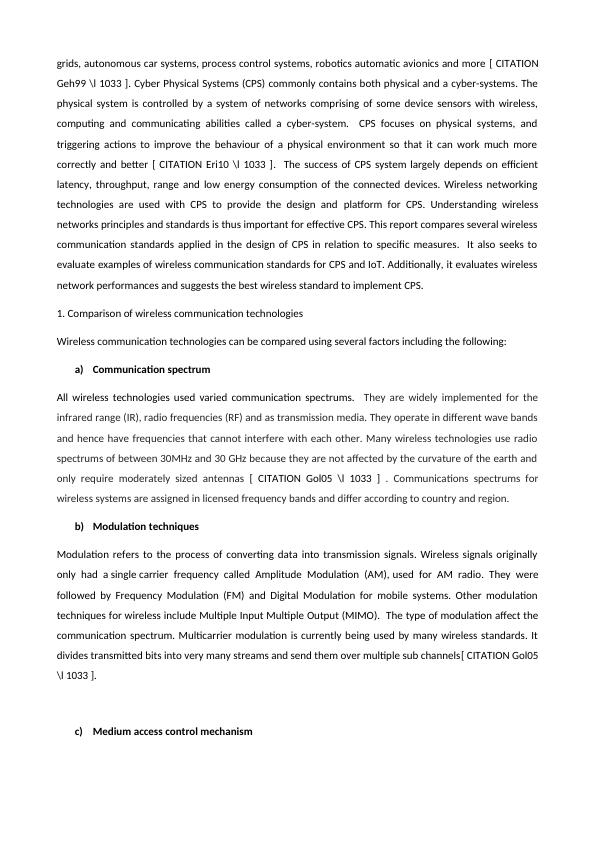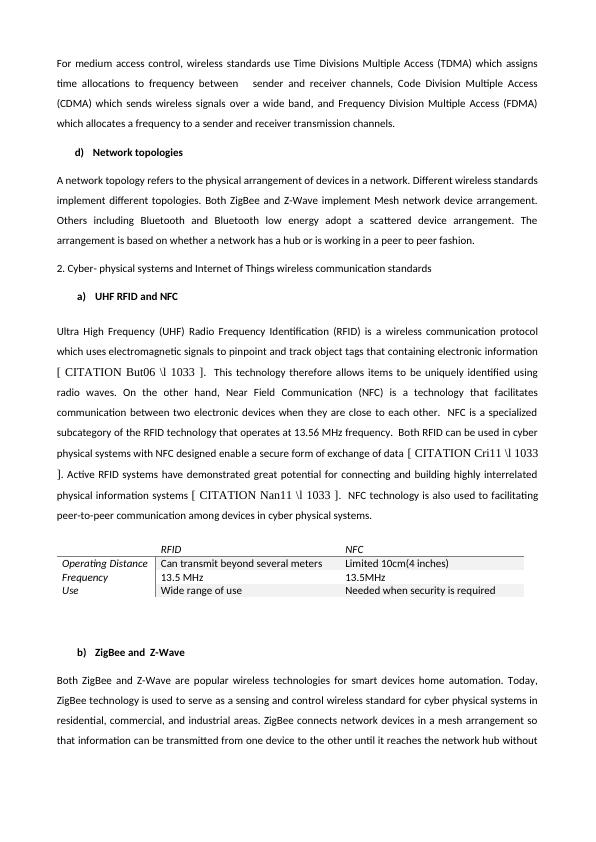Cyber-Physical Systems
Added on 2021-05-30
8 Pages2449 Words358 Views
Cover PageIntroduction The design of cyber-physical systems is more and more dependent on wireless networks, sensors andactuators that are connected together by IoT technology. Cyber Physical Systems (CPS) can include smart

grids, autonomous car systems,process control systems, robotics automatic avionics and more [ CITATIONGeh99 \l 1033 ]. Cyber Physical Systems (CPS) commonly contains both physical and a cyber-systems. Thephysical system is controlled by a system of networks comprising of some device sensors with wireless,computing and communicating abilities called a cyber-system. CPS focuses on physical systems, andtriggering actions to improve the behaviour of a physical environment so that it can work much morecorrectly and better [ CITATION Eri10 \l 1033 ]. The success of CPS system largely depends on efficientlatency, throughput, range and low energy consumption of the connected devices. Wireless networkingtechnologies are used with CPS to provide the design and platform for CPS. Understanding wirelessnetworks principles and standards is thus important for effective CPS. This report compares several wirelesscommunication standards applied in the design of CPS in relation to specific measures. It also seeks toevaluate examples of wireless communication standards for CPS and IoT. Additionally, it evaluates wirelessnetwork performances and suggests the best wireless standard to implement CPS. 1. Comparison of wireless communication technologiesWireless communication technologies can be compared using several factors including the following:a)Communication spectrum All wireless technologies used varied communication spectrums. They are widely implemented for theinfrared range (IR), radio frequencies (RF) and as transmission media. They operate in different wave bandsand hence have frequencies that cannot interfere with each other. Many wireless technologies use radiospectrums of between 30MHz and 30 GHz because they are not affected by the curvature of the earth andonly require moderately sized antennas [ CITATION Gol05 \l 1033 ] . Communications spectrums forwireless systems are assigned in licensed frequency bands and differ according to country and region. b)Modulation techniques Modulation refers to the process of converting data into transmission signals. Wireless signals originallyonly had asinglecarrier frequency called Amplitude Modulation (AM),used for AM radio. They werefollowed by Frequency Modulation (FM) and Digital Modulation for mobile systems. Other modulationtechniques for wireless include Multiple Input Multiple Output (MIMO). The type of modulation affect thecommunication spectrum. Multicarrier modulation is currently being used by many wireless standards. Itdivides transmitted bits into very many streams and send them over multiple sub channels[ CITATION Gol05\l 1033 ].c)Medium access control mechanism

For medium access control, wireless standards use Time Divisions Multiple Access (TDMA) which assignstime allocations to frequency between sender and receiver channels, Code Division Multiple Access(CDMA) which sends wireless signals over a wide band, and Frequency Division Multiple Access (FDMA)whichallocates a frequency to a sender and receiver transmission channels. d)Network topologiesA network topology refers to the physical arrangement of devices in a network. Different wireless standardsimplement different topologies. Both ZigBee and Z-Wave implement Mesh network device arrangement.Others including Bluetooth and Bluetooth low energy adopt a scattered device arrangement. Thearrangement is based on whether a network has a hub or is working in a peer to peer fashion. 2. Cyber- physical systems and Internet of Things wireless communication standards a)UHF RFID and NFCUltra High Frequency (UHF) Radio Frequency Identification (RFID) is a wireless communication protocolwhich useselectromagnetic signals to pinpoint and track object tags that containing electronic information[ CITATION But06 \l 1033 ]. This technology therefore allows items to be uniquely identified usingradio waves. On the other hand, Near Field Communication (NFC) is a technology that facilitatescommunication between two electronic devices when they are close to each other. NFC is a specializedsubcategory of the RFID technology that operates at 13.56 MHz frequency. Both RFID can be used in cyberphysical systems with NFC designed enable a secure form of exchange of data [ CITATION Cri11 \l 1033]. Active RFID systems have demonstrated great potential for connecting and building highly interrelatedphysical information systems [ CITATION Nan11 \l 1033 ]. NFC technology is also used to facilitatingpeer-to-peer communication among devices in cyber physical systems. RFIDNFCOperating DistanceCan transmit beyond several metersLimited 10cm(4 inches) Frequency 13.5 MHz13.5MHzUseWide range of useNeeded when security is requiredb)ZigBee and Z-Wave Both ZigBee and Z-Wave are popular wireless technologies for smart devices home automation. Today,ZigBee technology is used to serve as a sensing and control wireless standard for cyber physical systems inresidential, commercial, and industrial areas. ZigBee connects network devices in a mesh arrangement sothat information can be transmitted from one device to the other until it reaches the network hub without

End of preview
Want to access all the pages? Upload your documents or become a member.
Related Documents
Wireless Networks and Security - Doclg...
|9
|2701
|60
Wireless Communication Technologies for Cyber-Physical Systemslg...
|9
|2747
|158
Wireless Network and Securitylg...
|8
|2312
|88
Wireless Networks Assignmentlg...
|12
|2732
|95
Wireless Network and Security - Assignmentlg...
|8
|2350
|16
Wireless Network and Security Name of the University Author's Namelg...
|9
|2695
|285
